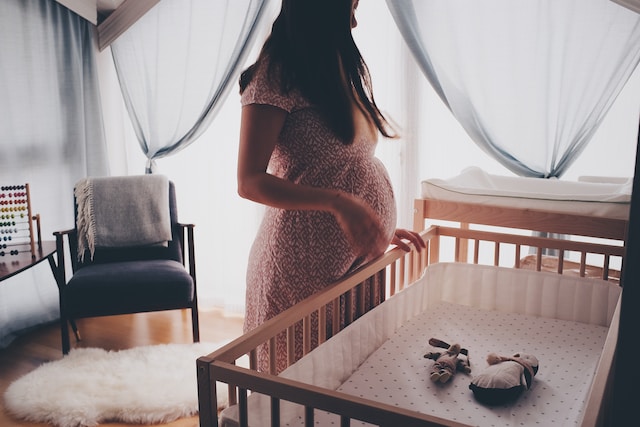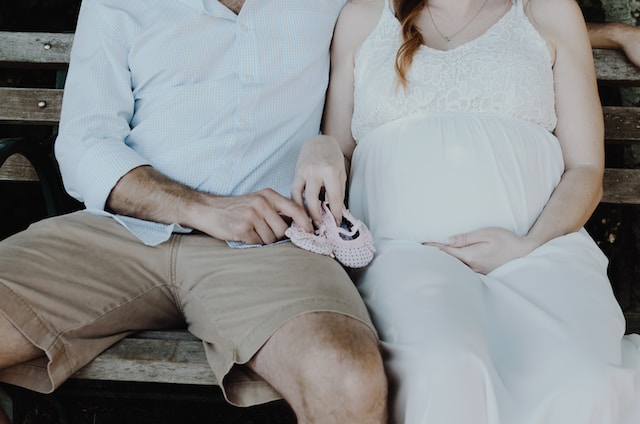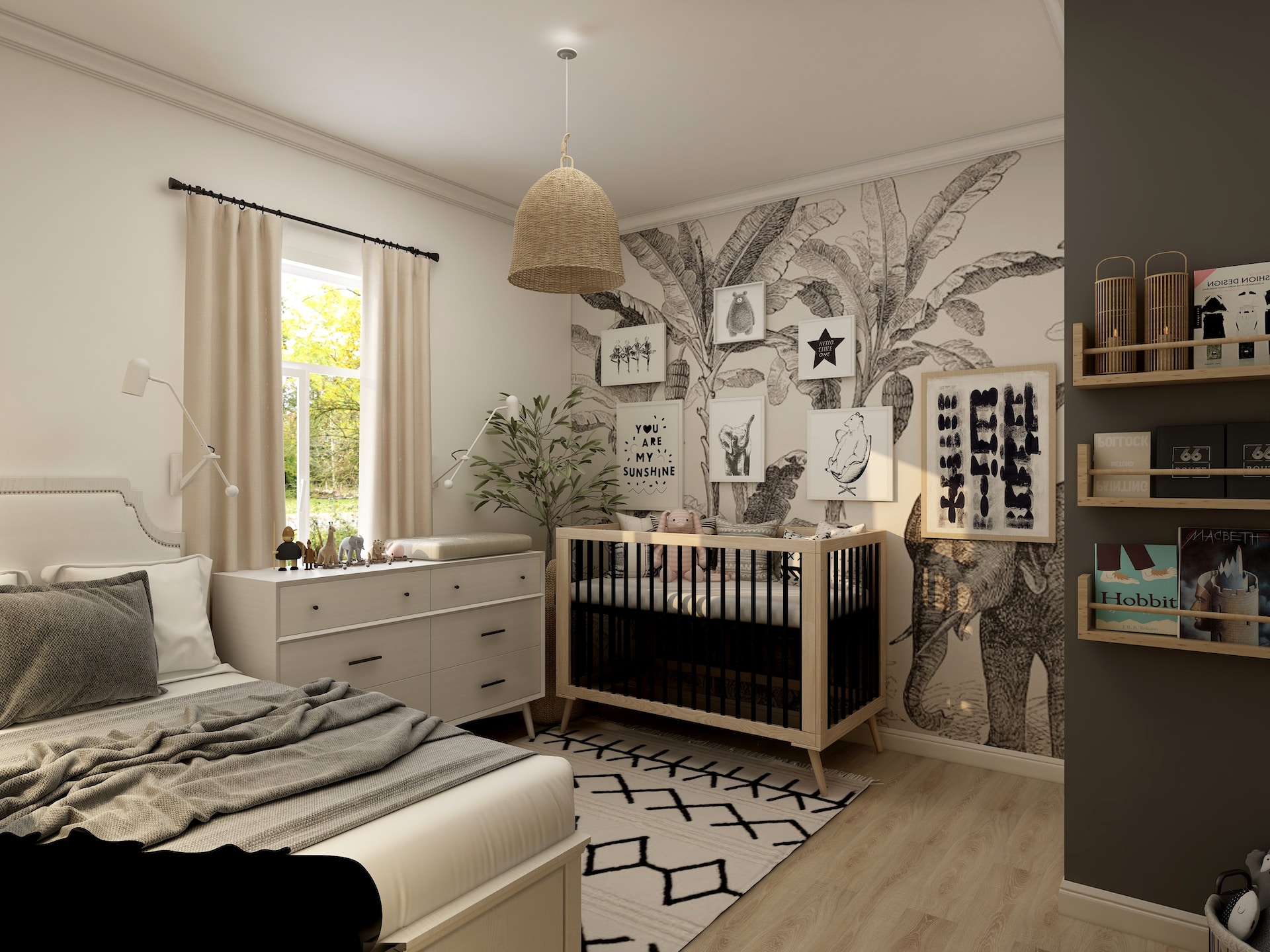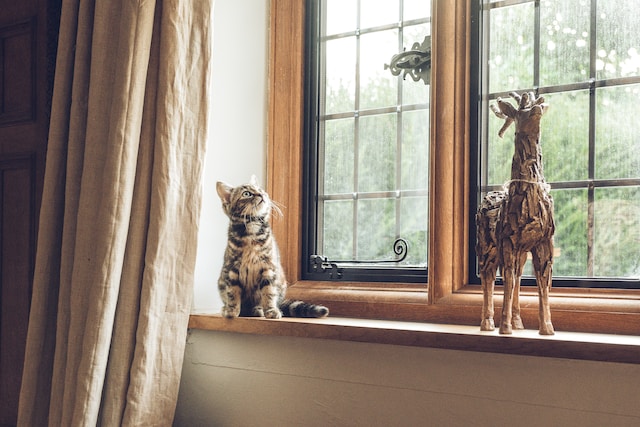Nesting for new parents is described as the overwhelming desire to get your home ready for your new baby. The one word that sticks out is overwhelming, as creating a safe and welcoming environment for your little one is a top priority. But, we will give you all the tips to make overwhelming manageable. From setting up a baby-friendly nursery to organizing baby supplies, every detail matters, and following the tips and suggestions in this guide, you can create a safe and comfortable space for your little bundle of joy.
Organizing the nursery
Preparing for the arrival of a new baby is an exciting journey filled with anticipation and joy. As parents-to-be, one of the most rewarding tasks in this process is setting up the nursery—a space that will soon be filled with laughter, love, and cherished memories.
- Crib: Choose a safe and sturdy crib for your baby to sleep in. Make sure it meets current safety standards, and position it away from windows, cords, and other potential hazards.
- Dresser: A dresser with ample storage space is a must-have in the nursery. Keep baby clothes, blankets, and other essentials neatly organized in the drawers for easy access.
- Rocker or glider: A comfortable rocking chair or glider is a great addition to the nursery. It provides a cozy spot for feeding, cuddling, and comforting your baby.
- Storage: Invest in storage solutions such as bins, baskets, and shelves to keep baby items organized. Label each storage container and designate specific areas for diapers, wipes, toys, and other essentials.
By organizing the nursery with these key elements in mind, you can create a welcoming and functional space for your little one. Remember to regularly declutter and rearrange as your baby grows to maintain an organized and clutter-free environment.
Setting up essential stations
When preparing your home for a new baby, setting up stations will help you navigate parenthood with ease. These include a changing station, nursing station, medicine cabinet, bath station, and postpartum kit. By organizing these areas and stocking them with necessary supplies, you’ll be well-prepared for the arrival of your little one.
Changing station
A dedicated changing station will be your go-to spot for diaper changes. Stock it with diapers, wipes, diaper rash cream, and a changing pad. Keep a trash bin nearby for easy disposal of dirty diapers, Consider adding a diaper pail with a secure lid to contain odors.
Nursing station
For breastfeeding mothers, a comfortable nursing station is needed. Include a comfortable chair or glider, nursing pillow, burp cloths, and a small table to hold items like water, snacks, and a book or magazine. Having a designated space for breastfeeding will help create a peaceful and relaxing atmosphere for you and your baby.
Medicine cabinet and bath station
Designate an area in your home for your baby’s medicine cabinet and bath supplies. Stock the medicine cabinet with essentials like a thermometer, infant pain reliever, nasal aspirator, and nail clippers. In the bath station, organize baby-friendly soaps, shampoos, towels, washcloths, and a bathtub or bath seat for bathing your little one safely.
Postpartum kit
Don’t forget to create a postpartum kit for yourself to aid in your recovery. Include maternity pads, nursing pads, nipple cream, comfortable underwear, and any prescribed medications. Having these items readily available will guarantee you can focus on bonding with your baby without worrying about personal care needs.

Putting together baby gear
Preparing for the arrival of your new baby involves more than just setting up a nursery. It also means putting together all the necessary baby gear for your little one to be comfortable and safe.
- Baby Swing: A baby swing provides a soothing motion to help calm and entertain your baby. Follow the manufacturer’s instructions to assemble it correctly and securely.
- Bassinet: Setting up a bassinet will provide a cozy sleeping space for your newborn. Make sure to assemble it according to the instructions and confirm it is stable and secure.
- Pack ‘n Play: This versatile piece of baby gear serves as a crib, playpen, and changing station. Follow the instructions to set it up properly and safely.
- Play Gym: A play gym provides a stimulating environment for your baby to develop their motor skills and entertain themselves. Assemble it per the manufacturer’s guidelines, ensuring all parts are securely attached.
- Stroller: Putting together a stroller involves attaching wheels, handles, and any additional accessories. Consult the instruction manual to assemble it correctly, and all parts are securely fastened.
- Car Seat: Properly installing a car seat is of the utmost importance for your baby’s safety during travel. Follow the manufacturer’s instructions and consult your vehicle’s manual for guidelines on securing the car seat.
Washing and sanitizing
Washing and sanitizing various items that your baby will come into contact with is an important step in creating a safe and healthy environment.
- Bottles: Before using them for the first time, wash baby bottles thoroughly with warm soapy water. You can also use a bottle brush to remove any residue. Sterilize the bottles by boiling them or using a bottle sterilizer.
- Pacifiers: Clean pacifiers with warm soapy water after each use. Sterilize them regularly by boiling them or using a pacifier sterilizing solution.
- Toys: Wash your baby’s toys regularly to remove dirt or bacteria. Follow the manufacturer’s instructions for cleaning and sanitizing each toy. For plastic toys, you can generally use a mixture of warm water and mild soap. Be sure to rinse them thoroughly and allow them to air dry.
- Clothes, Bedding, Towels, and Washcloths: Launder your baby’s clothes, bedding, towels, and washcloths using a gentle baby detergent. Wash them in hot water to kill germs, and dry them thoroughly. Avoid using fabric softeners or harsh chemicals that may irritate your baby’s skin.
- Baby Gear: Clean and sanitize items such as high chairs, bouncers, swings, and playpens regularly. Check the manufacturer’s instructions for cleaning and disinfecting each specific item.
By washing and sanitizing these items regularly, you can help prevent the spread of germs and keep your baby healthy and safe.
Baby-proofing tips
Creating a secure haven for your little one demands careful planning. These insights lay the foundation for a safe and inviting space for your newest family member. As babies grow and begin to explore their surroundings, these preparations become even more important for their safety and well-being.
- Outlet Covers: Cover all electrical outlets to prevent little fingers from poking into them.
- Safety Gates: Install safety gates at the top and bottom of stairs to prevent falls.
- Cabinet Locks: Use locks on cabinets and drawers containing potentially hazardous items like cleaning supplies, medications, or sharp objects.
- Corner Protectors: Place corner protectors on sharp furniture edges to prevent bumps and bruises.
- Window Guards: Install window guards to prevent falls, especially in rooms above ground level.
- Door Knob Covers: Use covers to prevent your child from opening doors to unsafe areas.
- Anchor Furniture: Secure heavy furniture like bookshelves and TVs to the wall to prevent them from tipping over.
- Cord Management: Keep cords for blinds, curtains, and electronics out of reach to prevent strangulation hazards.
- Stove Knob Covers: Use covers to prevent your child from turning on the stove.
- Lock Away Hazardous Items: Store cleaning supplies, toiletries, and other hazardous items out of reach.
- Secure Heavy Objects: Check that heavy objects like TVs are stable and cannot be pulled down.
- Remove Small Objects: Keep small objects that could be choking hazards out of reach.
- Secure Rugs: Use non-slip pads or double-sided tape to secure rugs and prevent trips and falls.
- Cover Sharp Edges: Use edge protectors on furniture with sharp edges.
- Secure Blinds and Curtains: Tie up cords or use cordless blinds to prevent strangulation.
- Lock Away Medications and Vitamins: Keep all medications and vitamins in a locked cabinet.
- Keep Small Appliances Out of Reach: Store items like toasters and blenders where children can’t access them.
- Install Toilet Locks: Prevent children from accessing the toilet bowl.
Remember, every home is unique, consider your specific layout and any individual risks. Regularly reassess your baby-proofing efforts as your child grows and becomes more mobile. This will help you adapt to their changing needs and safety.

Supporting your partner
Preparing for the arrival of a new baby involves physical preparations and emotional support for your partner. During this time, your partner may experience various challenges, such as adjusting to breastfeeding and recovering from childbirth. Being a supportive partner can help make this transition smoother for both of you.
Breastfeeding Support: Breastfeeding can be a beautiful yet challenging experience for new mothers. You can support your partner by educating yourself about breastfeeding techniques, attending breastfeeding classes together, and offering encouragement and reassurance. Help with tasks around the house to give her more time to rest and bond with the baby.
Postpartum Recovery: Supporting your partner through postpartum recovery involves understanding the need for healing after childbirth. Show your support by actively listening to her and being her emotional anchor. Assist with household tasks like cooking and cleaning to ease her responsibilities. Encourage self-care and rest, reminding her of her incredible job during this time
Emotional Support: Becoming a parent can bring a wave of emotions for both you and your partner. Be patient and understanding as you navigate this new chapter together. Create opportunities for open and honest communication, allowing your partner to express her concerns or fears. Offer words of affirmation, love, and appreciation to strengthen your bond and reassure her that she’s not alone in this journey.
Additional Resources for Support:
- Breastfeeding Support Groups: Encourage your partner to join local breastfeeding support groups or online communities where she can connect with other breastfeeding mothers who can share their experiences and provide advice.
- Postpartum Mental Health: Be aware of the signs of postpartum depression and anxiety. If you notice any concerning symptoms, encourage your partner to seek professional help and offer your unwavering support throughout her healing process.
- Parenting Classes: Consider attending parenting classes together to gain knowledge and skills to help you navigate parenthood’s challenges. These classes often provide valuable information on postpartum care and support.
Supporting your partner when preparing for a new baby is valuable for her well-being and your family’s overall harmony. Being present, understanding, and supportive can create a nurturing environment to establish a strong and loving bond with your new addition.
Protect your haven with home insurance coverage
As you prepare your home for a new baby, consider every aspect contributing to a safe and nurturing environment. One often overlooked but invaluable component is home insurance coverage.
Home insurance provides an extra layer of protection in unforeseen circumstances, such as potential accidents or disasters. Picture this: a late-night feeding, a baby sleeping peacefully, and suddenly, a burst pipe floods your kitchen. In these moments, home insurance steps in, offering not only peace of mind but also financial assistance to repair the damage.
By including home insurance coverage in your preparations, you’re ensuring your home remains a secure and comfortable haven for your growing family. It’s a small yet significant investment that can make a difference in those unexpected moments. Here’s to creating a safe and welcoming space for your little one!
Balancing work and family life
Preparing for a new baby is an exciting and busy time, and finding the right balance between work and family life is key.
Parental leave
One of the first steps in balancing work and family life is understanding your options for parental leave. Familiarize yourself with your company’s policies and any state or federal regulations that may apply. Discuss your plans with your employer for a stress-free transition and adequate time off to bond with your newborn.
Managing finances
Preparing for a new baby often comes with financial considerations. Assess your budget and make necessary adjustments to accommodate additional expenses. It’s a good idea to create a budget specifically for baby-related costs, such as diapers, formula, and childcare. Consider seeking advice from a financial planner to help you manage your finances effectively during this period.
Finding balance
Finding a balance between work and family life requires proactive planning and open communication. Prioritize your time and allocate it efficiently between work responsibilities and spending quality time with your family. Set realistic expectations and boundaries with your employer, and explore flexible work arrangements if they are available. Remember to also take care of yourself and make time for self-care to avoid burnout.
Preparation timeline for welcoming your new baby
First Trimester (Weeks 1-12)
Research and Planning:
- Start researching baby essentials and creating a checklist.
- Begin thinking about nursery layout and design.
Second Trimester (Weeks 13-27)
Assembling Baby Gear:
- Start assembling larger baby gear items like the crib, bassinet, and stroller.
- Read and follow the manufacturer’s instructions carefully.
Baby-Proofing:
Begin the process of baby-proofing. Focus on outlets, securing heavy furniture, and putting up safety gates.
Nursery Organization:
Set up essential stations like the changing station, nursing station, and medicine cabinet.
Third Trimester (Weeks 28-40+)
Completing Baby Gear Assembly:
Finish assembling any remaining baby gear items, such as swings, play gyms, and car seats.
Washing and Sanitizing:
Start washing and sanitizing baby items like bottles, pacifiers, toys, and baby clothes.
Final Touches in the Nursery:
Add finishing touches to the nursery, like bedding, decor, and additional storage solutions.
Double-Check Baby-Proofing:
Revisit and double-check all baby-proofing measures. Make sure everything is secure and in place.
Post-Birth:
Adjustments and Re-evaluations:
As your baby grows and becomes more mobile, regularly reassess baby-proofing efforts and adjust as needed.
You can also set up your nursery on a budget by shopping for secondhand furniture and repurposing items you already have. Every pregnancy and family situation is unique, so this timeline is a general guideline. Feel free to adjust it based on your specific circumstances and preferences. It’s always a good idea to start preparations early to avoid last-minute stress.

Preparing a home for a new baby is an exciting and important task that requires careful planning and organization. By following the tips provided in this guide, you can rest easy that your home is ready for the arrival of your little one. Each step plays a huge role in creating a baby-friendly home, from setting up essential stations to organizing the nursery, putting together baby gear, and washing and sanitizing. Taking the time to baby-proof your house, assemble the necessary baby gear, and create a clean and safe environment will provide peace of mind.
Remember, the journey of preparing a home for a new baby is just the beginning. As your little one grows, your home will evolve and adapt to their needs. Enjoy this special time and embrace the joy and challenges of parenthood!




